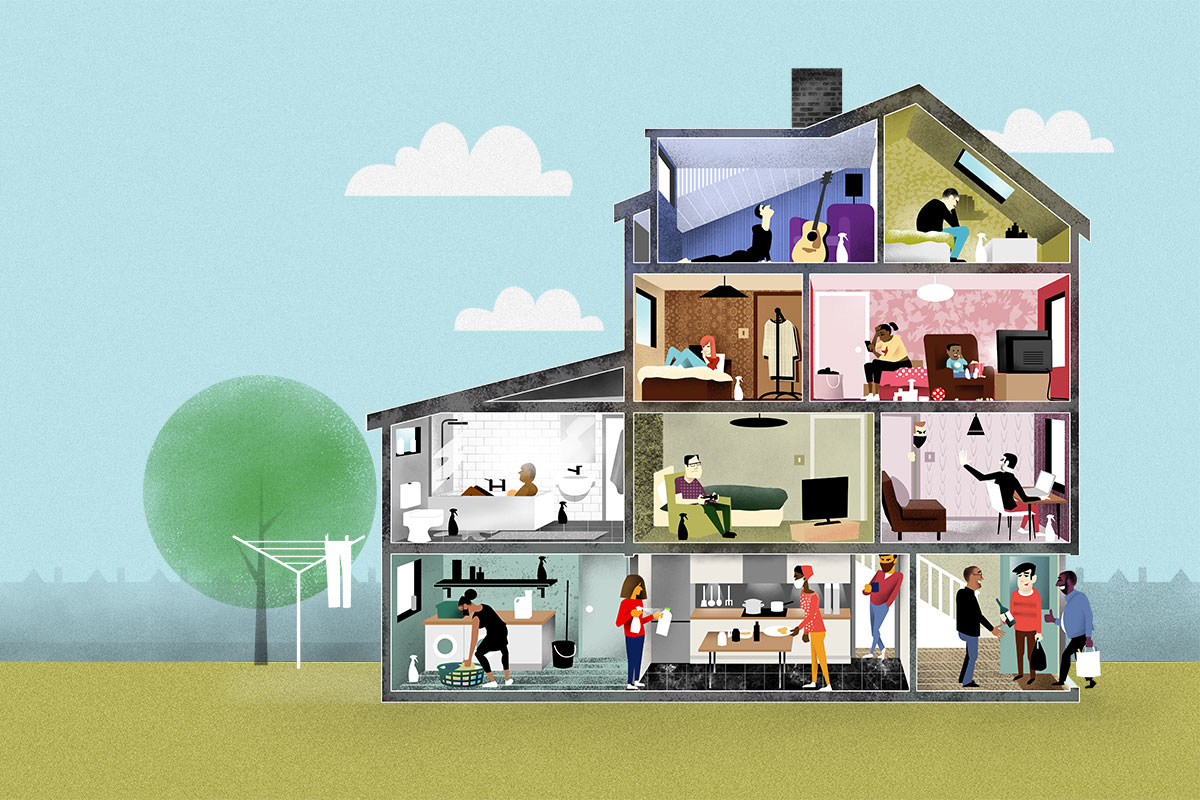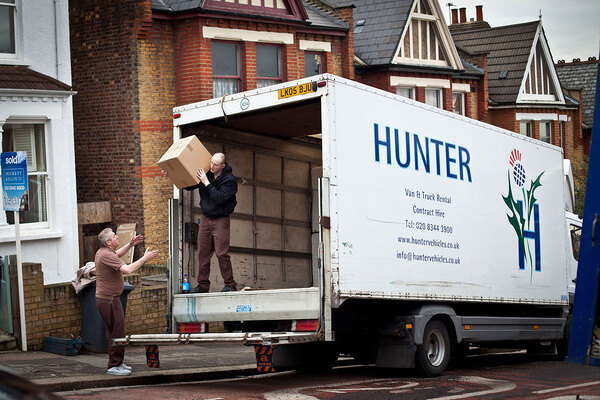‘Going to the kitchen is scary’: lockdown puts shared rented housing in the spotlight
The difficulties of self-isolating in HMOs have been overlooked during the pandemic. Peter Apps finds out what it is like and why shared housing has become so common. Illustration by Pete Ellis
Silvia Andres works as a flight attendant for a large airline and earns a reasonable £1,800 a month after tax, but this is not enough to afford a home of her own. Instead, she pays £520 a month for a room in a house in Croydon, which she shares with four people she does not know.
Aged 28, this is the best her salary can get her in London. “This is much cheaper than living alone and most people cannot afford to live in a one-bed apartment or a studio, so you end up in one of these,” she tells Inside Housing.
Her experience is increasingly common for any single people who have lived in a big city in the UK over the past few years. One wage does not cover the rent any more.
This state of affairs has been a problem for some time, but coronavirus has made it more urgent. How can ‘generation rent’ self-isolate when they do not have a self-contained home to isolate in?
“When I hear somebody coughing, I get really scared,” Ms Andres says. “Over the past few weeks, one guy downstairs was bringing people in from outside, who we don’t know.
“Going to the kitchen is scary, because you just can’t do it without touching the handle of the door, the light switch, the bannister. People don’t clean up after themselves, so how can you stay safe?”
Houses in multiple occupation (HMOs) have been a growing feature of the UK housing market for some time. Defined simply as a property where more than one household shares a basic amenity such as cooking or bathroom facilities, HMOs are no longer the preserve of students and young graduates.
This growth has been rapid. In 2012/13, the earliest year for which Inside Housing can find comparable data, there were an estimated 429,065 HMOs nationwide. Last year, there were 515,862 – a rise of 86,797 (20%).
In its official guidance to local authorities, the government notes that the growth is particularly rapid among migrant workers, young professionals and those locked out of the general housing market, with HMOs now housing “the most vulnerable people in our society”.
This high number of people living in close quarters feels like something that should have been a major concern when a highly infectious disease began ripping through the population. But it seems to have been largely overlooked.
Amid pages and pages of guidance for businesses, advice for tenants of HMOs was limited to a short passage in its broader guidance for landlords and tenants. All this did was link to other guidance about cleaning, distancing and staying at home when sick.
This picture should concern those who work in the social rented sector. Twenty years ago, 36% of people in the lower half of the country’s income distribution lived in social housing and 12% in the private rented sector (PRS). But this has been steadily reversing, and by 2017, 28% lived in social housing and 22% in the PRS. Now 40% of private renters are in relative poverty.
So the struggles these residents face during the pandemic underscore the need for social housing and the consequences of its depletion.
In a survey of 1,500 renters carried out by pressure group Generation Rent, one in three renters who live in shared housing felt they could not stay safe in line with government guidance. In shared rented housing, it was nine in 10.
“People have been telling us that’s because they’re sharing facilities with multiple housemates, so a kitchen and a bathroom. And it’s very difficult to keep those clean and safe and to practice social distancing,” says Caitlin Wilkinson, policy and public affairs manager at Generation Rent. “If the quality of housing isn’t good enough for people to isolate in, people are going to get ill.”
The nature of the quick turnover of residents in these homes also makes it difficult. “Another difficulty people have told us about is because people in HMOs are on separate contracts, people leave and that means agents put them under pressure to do viewings or new tenants move in,” she adds.
“From a social distancing perspective, the environment creates many challenges,” says Professor Darren Smith of Loughborough University, who has written several papers on the growth and demographics of HMOs.
“The sharing of kitchen utensils and cutlery and cups, touching kettles and fridge doors, when people are coming in and using things at different times will really heighten the risk. Very often, HMOs are terraced houses with relatively small gardens and living rooms and that two-meter threshold is just going to be very hard to maintain.”
Space is also an issue for those who have to self-isolate. Those who have developed symptoms in shared housing have essentially been told to confine themselves to a single room for 14 days.
“The combination of the small space with the insecurity of knowing that you might be evicted when the government ban ends, [has led to] people telling us about sleepless nights, about becoming physically ill from the stress of this,” adds Ms Wilkinson.
A thorough analysis of a link between HMOs and the spread of virus will not be possible for some time, but there are early hints. Poor London boroughs are hotspots of HMO use as well as hotspots of coronavirus death.
In Newham, east London, which has the worst overcrowding in the capital, 37,162 private rented properties were recorded in a borough-wide licensing scheme, of which many will be HMOs. It also has a death rate of 144.3 per 100,000 compared with 25.3 per 100,000 in less deprived areas.
“The combination of the small space with the insecurity of knowing that you might be evicted when the government ban ends, [has led to] people telling us about sleepless nights, about becoming physically ill from the stress of this”
There are various factors which will likely be the cause – including poor air quality, multigenerational homes and a large number of people in jobs which have continued through lockdown. But the correlation between the borough’s housing crisis and number of coronavirus deaths is unlikely to be a coincidence.
Further figures dredged up by Inside Housing via analysis of various councils’ HMO registers, obtained under Freedom of Information Act laws, underscore the scale of the problem. These registers compile data differently and appear to have varying depths of coverage of the local market, so do not lend themselves to comparison – but they do paint a picture of the difficulties people will have isolating.
Tower Hamlets’ licensing register suggests that kitchens in the borough’s larger HMOs are shared by an average of five households. In two instances, houses with 12 bedrooms are registered as having just one kitchen; there are 12 where it is shared by more than 10.
A kitchen in some HMOs can be shared between up to 12 different bedrooms (picture: Getty)
In Birmingham, there are 2,401 licensed HMOs, with a maximum occupancy of 16,490 – suggesting an average occupation of more than six people per home. In Croydon, almost 100 registered HMOs have just one shared bathroom, with some shared between 12 people. In Camden, 3,742 licensed HMOs house 17,003 people. In more than half, the kitchen is shared between at least four.
These figures only cover a small fraction of the HMOs in each of the areas referenced. Only larger properties require a licence from the local authority (those with five or more people from at least two households). This covers an estimated 139,966 properties according to local authority data returns, but only 63,574 actually have licences. This means just 12% of all HMOs in England are licensed at all.
And the licence itself means only limited regulation. The local authority will inspect for health and safety hazards, including fire doors, and can monitor to ensure the landlord is keeping the home in a habitable condition, but there is no real lever councils could pull to assist with social distancing or isolation in these homes.
“We don’t have anything extra going on, particularly, in regards to how to manage isolation in private residences – because of course any issues are mostly the responsibility of the tenant or landlord,” says a source at one large London borough.
The real question is less what should we have done to protect people once coronavirus started spreading, but why have we allowed the housing market to develop in such a way as to require so many people to live in these types of homes in the first place?
“There was a proliferation in the late-1990s due to the expansion of the student population,” says Professor Smith. “There was a lack of bed spaces because higher education is predominantly a migratory process. The HMO market stepped in to provide that unmet demand. That was combined with a restructuring of the tourist economy in coastal towns and the conversion of old B&Bs into private housing. At the same time, different factors were coming together: low interest rates, Right to Buy mortgages, a middle class seeking investment for their retirement.”
From these beginnings the HMO market has grown. From the landlord’s perspective, the primary driver is yield. “You can charge more rent than you can for a family because you can get people with multiple salaries in there,” adds Ms Wilkinson.
“The risk for the landlord is also reduced, because if one person leaves you can still collect rent from the other tenants.”
Buy-to-let lending increased from £9.1bn in 2000 to £240bn in 2017. As this sector grew, so did HMOs, with many now run by small non-professional landlords.
“There was a lack of bed spaces because higher education is predominantly a migratory process. The HMO market stepped in to provide that unmet demand”
An analysis of the market by Shawbrook Bank in 2016 agreed with this, estimating a 9% return from an HMO compared to a 6% return for traditional buy-to-let. It said that as a result, regular buy-to-let investors were increasingly letting out properties as HMOs, while what it termed the “smash-and-bash crowd” were actively seeking larger properties to “completely reconfigure to house up to six or seven tenants”.
This latter trend is probably the most disturbing, as it means the country’s stock of large family housing is actively being reduced by the growth of HMOs.
From the tenant’s perspective, the decision is unsurprisingly largely made on the basis of cost. A survey of 10,000 residents of shared properties carried out by listings website Spare Room showed that just 3% choose to do so for social reasons, while a total of 94% do so due to some form of financial pressure.
The benefits system and a lack of social housing also drives people towards HMOs. For single under-35s, Local Housing Allowance is capped at the ‘shared room rate’, meaning those who become reliant on benefits can only access the HMO market.
Well publicised shortages of social housing also contribute. As Shawbrook Bank candidly put it: “The falling provision of social housing during the austerity programme, as well as schemes such as the Right to Buy, has impacted this space, pushing social housing tenants in the direction of HMO landlords.”
If the country wants to reverse the growth of HMOs, then these are the levers to pull. People are choosing this form of housing because they cannot afford anything else. But until this is achieved, the HMO market will continue to grow. “If you have an average job like Primark or whatever, you cannot afford anything else,” says Ms Andres. “We are condemned to live in a house like this forever.”
In the new world of COVID-19, this is an even bigger problem than it was before.
More on coronavirus
To see all our coronavirus coverage to date – including the latest news, advice to providers, comment and analysis – use the link below.












